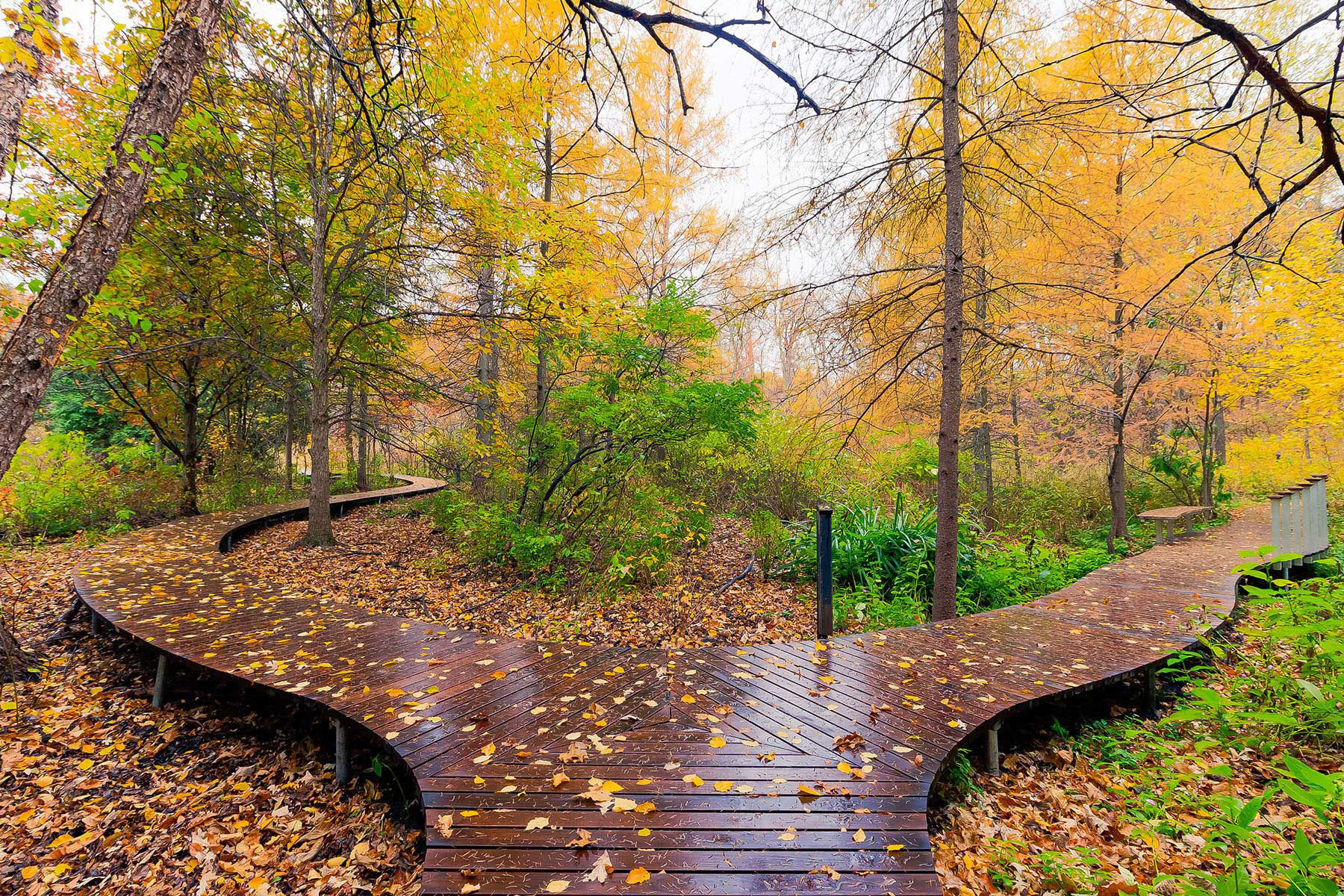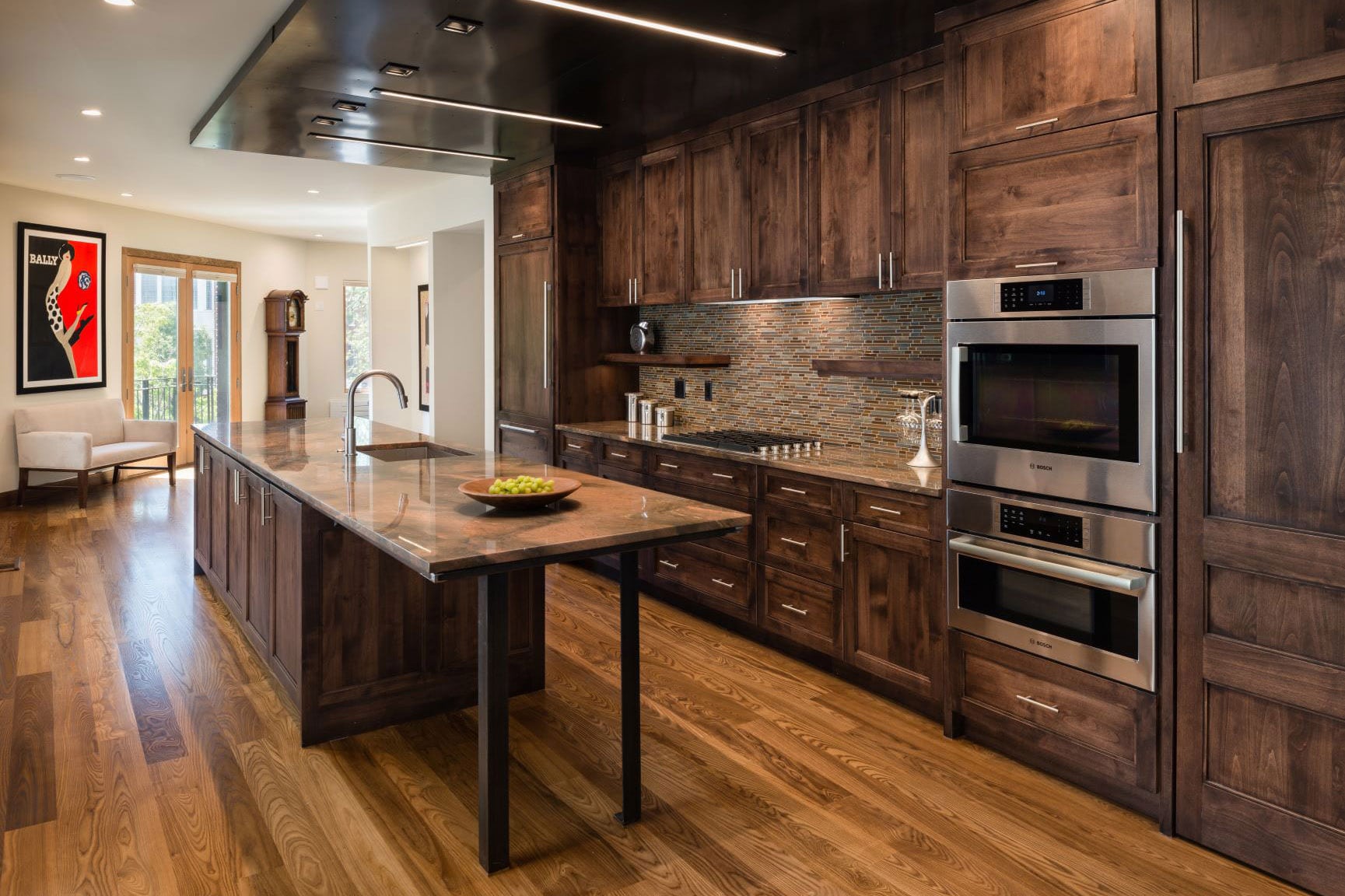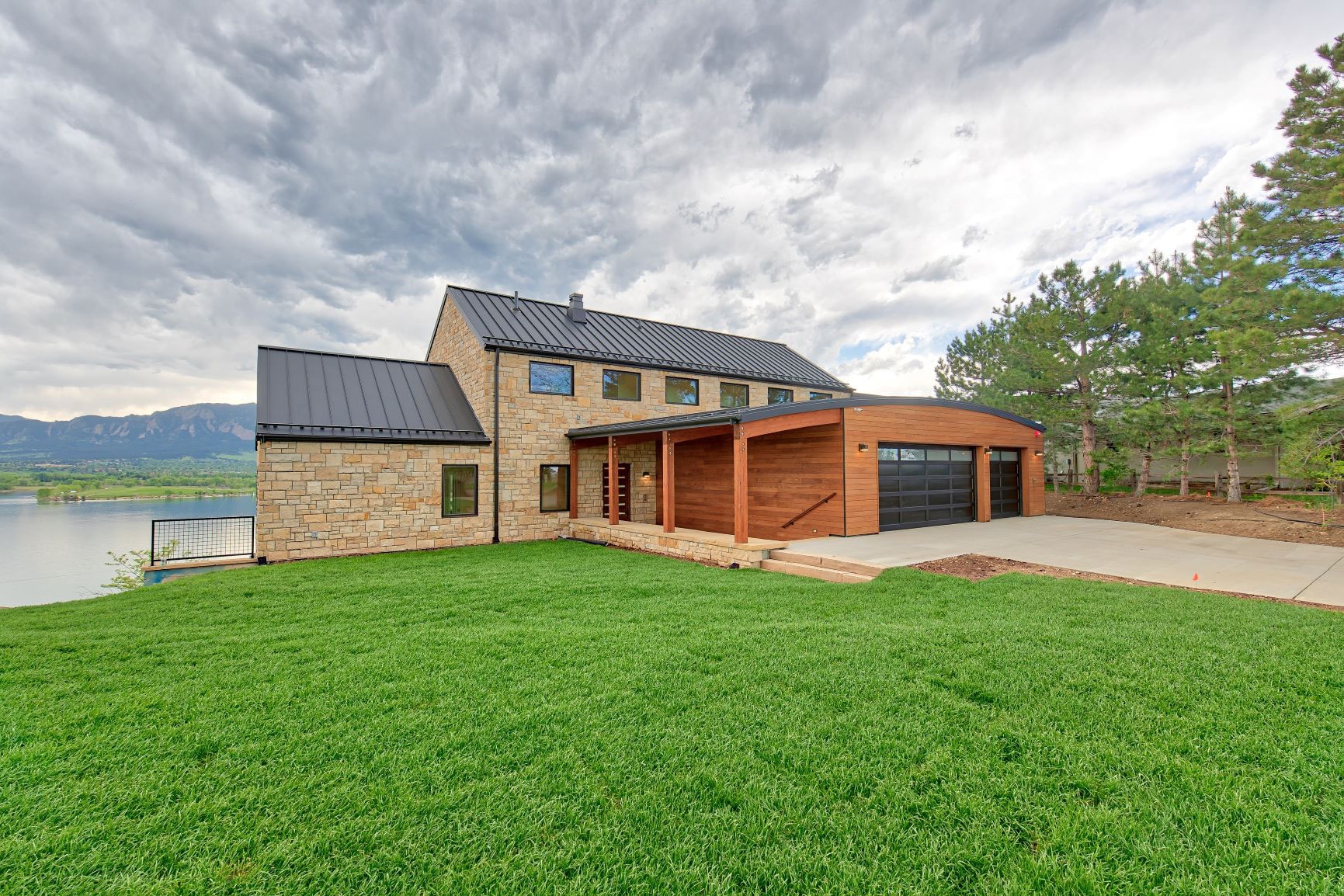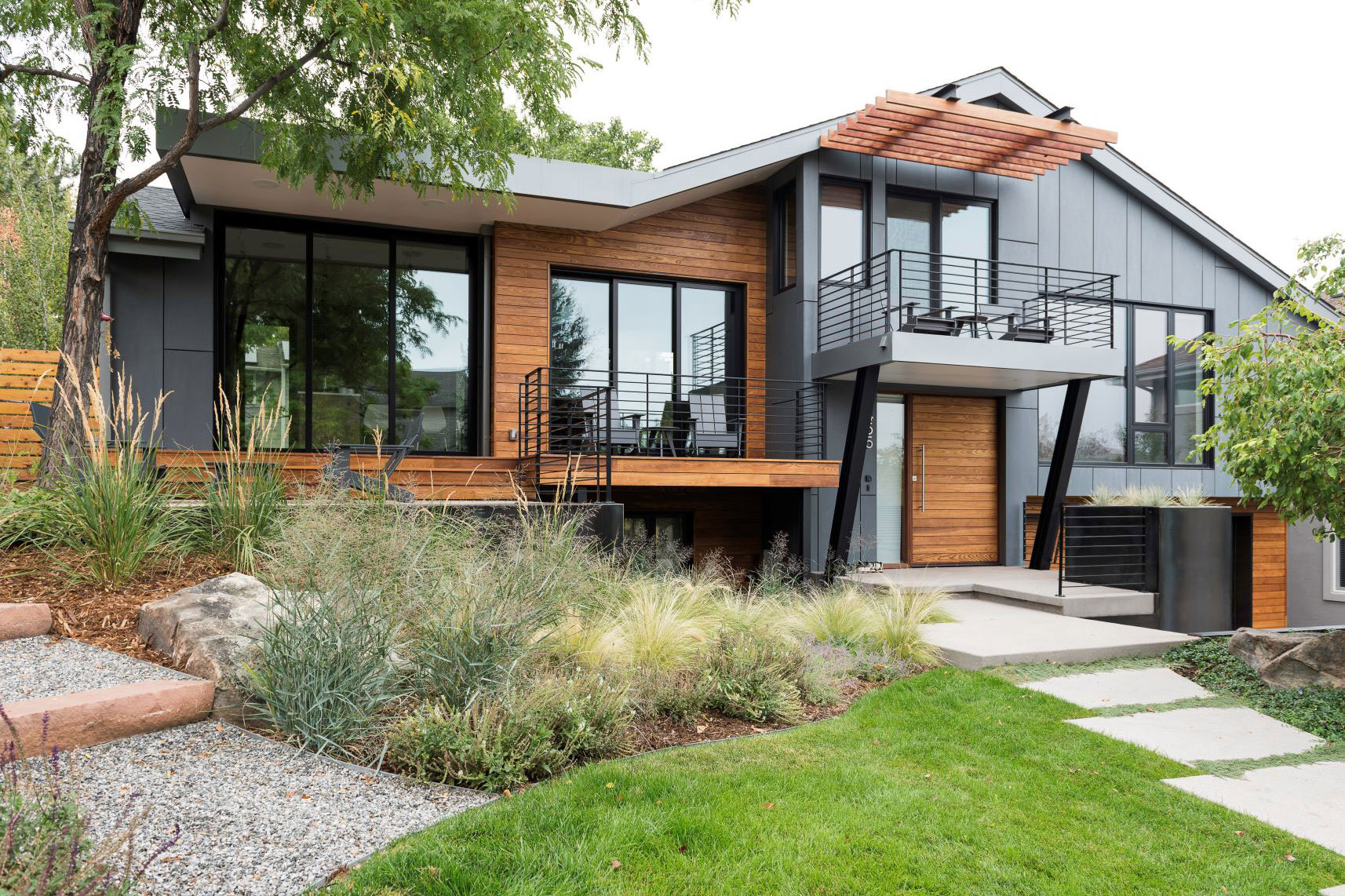How do you solve the problem of designing for longevity within a fragile environment?
The Eloise Butler Wildflower Garden is the first and oldest wildflower garden in the US. Roughly 60,000 annual visitors enjoy a vast array of more than 500 native wildflower species and 130 bird species throughout the park’s woodland, wetland, and prairie areas. When Twin Cities–based landscape architects Cuningham Group were tasked with overseeing a much needed enhancement to the park’s infrastructure, it was the design of a raised pathway and bridge structure that served as the focus for the project.

The Eloise Butler Wildflower garden is the first and oldest public wildflower garden in the US. This Arbor Wood wetland boardwalk made use of local boulevard trees impacted by the emerald ash borer. The trees were harvested, modified, and milled to create a durable and long-lasting pathway to supports the park’s delicate ecosystem. Photo courtesy of Arbor Wood
This pathway, vital to providing intimate access without disturbing the sensitive ecosystem within the garden, made use of thermally modified timber to solve two challenges at once. For one, local trees impacted by the emerald ash borer were given new purpose by being harvested, thermally modified, and milled to create this award-winning boardwalk—one which should last for several decades—without the use of any chemicals that could otherwise jeopardize this natural habitat.

Thermally modified timber is not only for exterior use. Designers and builders alike appreciate the material for its durability and naturally occurring rich tones on applications such as flooring and wainscoting. Photo courtesy of Arbor Wood
What is Thermally Modified Timber?
Thermally modified timber (TMT) is a natural wood product that has undergone a chemical change using heat and steam to improve outdoor stability. The modification process was first developed by the VTT Technical Research Centre of Finland in the early 90s and brought an important value add to one of the country’s most abundant natural resources.

FSC-certified and domestically sourced white ash destined for the modification kiln. Photo courtesy of Arbor Wood
During thermal modification, select-grade kiln-dried wood is subjected to a secondary high-heat thermal modification kiln where a chemical process called hydrolysis occurs. It is this breaking up of the hydroxyl groups in the wood’s cellular structure that increases both durability and biological resistance by permanently reducing the material’s tendency to absorb water and serve as a food source for mold, rot, fungal decay, and insects. The conversion of sugars to a nonfood source also turn the timber a darker, richer through-color, providing an appealing and refined aesthetic similar to the look of exotic hardwoods.
Although wood species like ash, oak, and pine are most common, thermal modification can be performed on many species to varying degrees of success.

The thermal modification process turns timber a darker, richer color, often making it look like a more exotic hardwood. Photo courtesy of Arbor Wood
Why Thermally Modified Wood?
Performance Plus Sustainability
Thermally modified wood has proven to be a great option in environments that are typically unforgiving to wood, including exterior siding and decking, interior flooring, or anywhere a low-maintenance natural wood product is desired. Less fiber saturation means that a natural wood product is now more dimensionally stable and less susceptible to humidity and temperature-induced expansion and contraction, which is ideal for climates with wide fluctuations, like the Pacific Northwest, Midwest, and East Coast.
Domestic Production & Environmental Stewardship
As the process gives new life and improved durability across a range of wood types, thermally modified wood producers like Arbor Wood are sourcing timber domestically from forests that are managed or certified to Forest Stewardship Council (FSC) criteria. By modifying and milling a finished product in the US, domestic production of thermally modified wood also lowers the carbon footprint and opens up new choices to architects and designers with regard to aesthetic, species, and even the origin of the raw timber to be used.

The award-winning Bell Museum of Natural History on the University of Minnesota campus incorporated more than 21,000 square feet of Arbor Wood thermally modified white pine for its façade. The wood came from a forest located just 30 minutes away from the building site. Photo courtesy of Arbor Wood
This process proved important to global architecture firm Perkins + Will when designing the Bell Museum & Planetarium at the University of Minnesota, recipient of nearly a dozen civic, design, and environmental stewardship awards. The project was intended to showcase the region’s natural history and called for a natural wood façade that was produced domestically, FSC-certified, installed without the need for finish or stain, and would last 25-plus years. Minnesota-sourced white pine was harvested, thermally modified, and milled to meet this requirement and was the largest commercial installation of white pine cladding in the country.
Thermally modified wood also provides for a number of LEED contributing credits, including those for rapidly renewable material and low-emitting materials. With current design and building trends focusing again on natural and eco-conscious materials, thermally modified timber has emerged as a compelling material for many applications.

Thermal modification can be performed on many species of wood, though ash, oak, and pine are most common. Photo courtesy of Arbor Wood
From Siding to Snowboards
As more people become familiar with thermally modified timber, architects, designers, and manufacturers are turning to the material as a viable option for a wide range of applications. Fabricators and contractors are finding that the improved stability and significant reduction in warping or cupping means better yield and less waste. The dust is nontoxic, and the material is lighter in weight, often making it an easier and more predictable material to work with.
Although thermally modified timber is most commonly produced in siding, decking and flooring profiles, many producers such as Arbor Wood offer a line of dimensional lumber options and can also create to custom specification.

Thermally modified wood is common in siding and decking, though it can be customized for any project, including furniture, sports equipment, and even guitars. Photo courtesy of Arbor Wood
Due to its beautiful color and environmental stability, thermally modified timber is seeing adoption beyond more traditional architectural applications. Both major guitar manufacturers and smaller luthiers alike are turning to thermally modified timber for more stable guitar necks, bridges, and bracing. Action sports companies appreciate the lighter weight and beautiful tones when designing anything from snowboards to stand-up paddle boards, and the material is making its way in to both traditional and outdoor furniture manufacturers as a low-maintenance sustainable alternative to exotic hardwoods.
In short, the emergence of thermally modified timber is bringing new life and utility to both domestic hardwood and softwood in the US.


